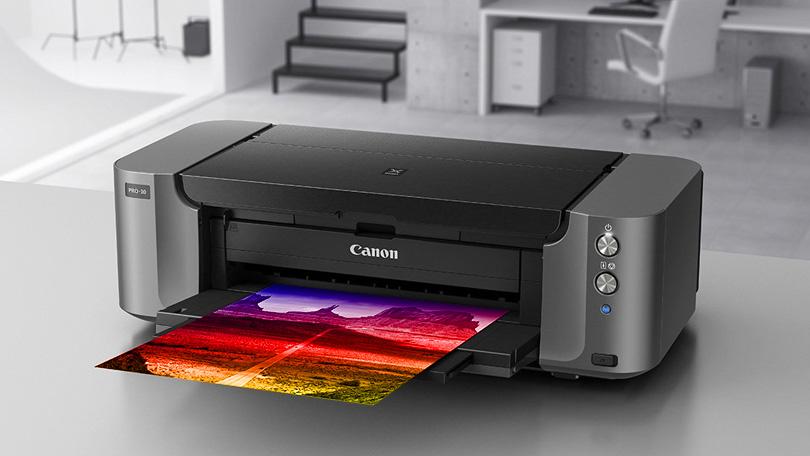Pigment-based inkjet printers are the go-to choice for people who want their prints to be of top-tier quality and last for a long time.
Architects, engineers, contractors, graphic artists, museums, marketing, and advertising, and photographers are among the examples of those who make use of the powers of a good pigmented ink printer.
So if you want to enjoy the benefits of these artistic machines but don’t know how or which one to choose, I’ve tailored a list including the best pigment ink printers on the market to help you make a decision.
List of The Best Pigment Inkjet Printers:
- Canon iP8720 – Best for Novices and Beginners
- Epson SureColor P400 – Best Pigment Ink Printer for the Features
- Canon PIXMA PRO-10 – Best Professional Pigment Ink Printer
- Epson Stylus C88+ – Best Budget Pigment Ink Printer
- Epson SureColor P600 – An Excellent Photo Printer
Pigment Based Inkjet Printers – Comparison Table:
| Ink Printer | Cartridges | Resolution |
| Canon IP8720 | 6 | 9600 x 2400 DPI |
| Epson SureColor P400 | 8 | 5760 x 1440 DPI |
| Canon PIXMA PRO-10 | 10 | 4800 x 2400 DPI |
| Epson Stylus C88+ | 4 | 5760 x 1400 DPI |
| Epson SureColor P600 | 9 | 5760 x 1440 DPI |
The 5 Best Pigment Ink Printers for 2020
1. Canon iP8720 – Best for Novices and Beginners
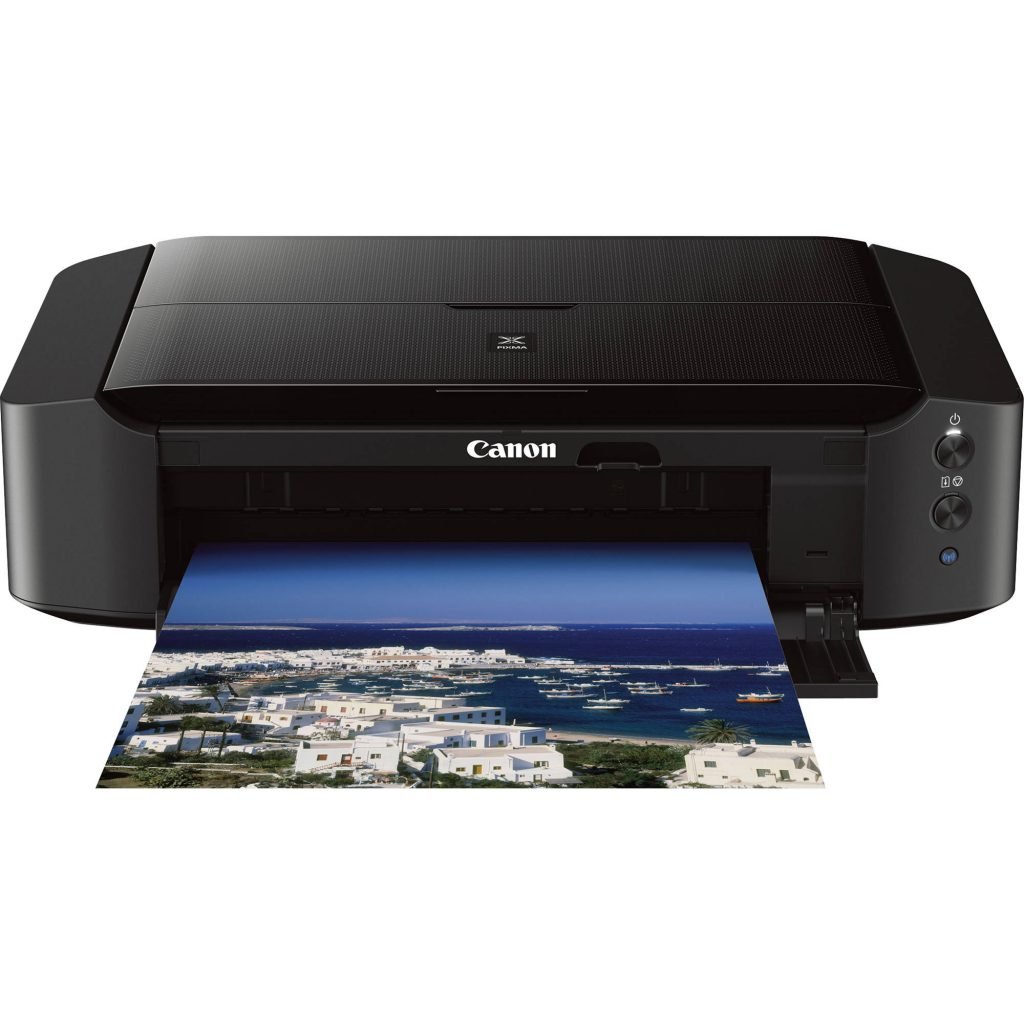
If you really want to take advantage of the benefit of a true pigment-based printer, the Canon iP8720 is a great choice.
This superb photo printer is equipped with a 6-color ink system, including yellow, magenta, cyan, gray, black, and photo black. It can print at an amazing resolution of 9600 x 2400 DPI and has a print speed of 14.5 PPM for monochrome prints and 10.4 PPM for color ones. Although it’s not the fastest, it does give you outstanding results and great colors.
While most printers of its class can only go as far as 8 x 14 inches, this one can do 13 x 19 borderless prints.
As for connectivity, the Canon iP8720 comes with a USB port and has wireless print capabilities, so you can print from your tablet, smartphone (both Android and iOS), laptop, or digital camera. It also supports third-party applications such as Pixma Printing Solutions, Apple’s AirPrint, and cloud-based printing such as iCloud or Google Cloud Print.
Pros:
- Reasonable price
- Can print up to 13 x 19 inches
- WiFi and PictBridge capability
- Can print on printable optical discs
Cons:
- Single paper tray with a capacity of only 150 sheets
- PictBridge over USB cable isn’t supported
Bottom Line
While the Canon iP8720 may not be jam-packed with high-end technologies like the Epson SureColor P600 below or the Canon Pixma Pro-10, it’s still a highly recommended pigment ink printer for beginners.
2. Epson SureColor P400 – Best Pigment Ink Printer for the Features
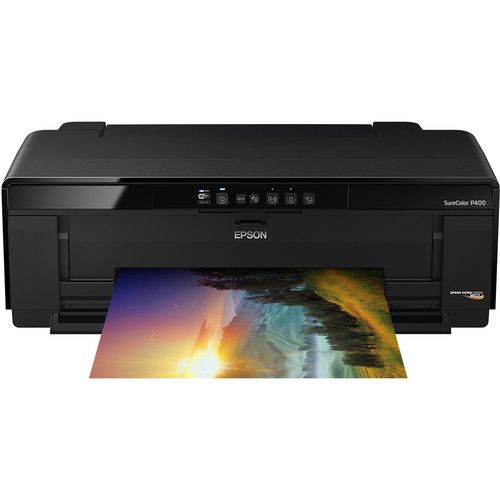


If you’re an illustrator or work in a photo studio, opting for the Epson SureColor P400 would be a wise decision.
This versatile pigment ink printer can produce 13-inch wide-format media as well as roll print and 129-inch panoramic prints.
Using an eight pigment-ink based system, this printer can produce Archival Ink output, which can last up to 200 years! So if you’re looking for something that stands the test of time, it’s a pretty safe choice.
Moreover, its resolution is 5760 x 1440 DPI, which is pretty high. It prints at speeds of 68 seconds for 8 x 10-inch prints and 82 seconds for 11 x 14-inch prints, taking its sweet time to produce the best quality prints. That’s why it’s quite pricey.
The Epson SureColor P400 comes with WiFi, Ethernet, and USB connectivity. However, it lacks an LCD panel through which you can control its processes and has a pretty large footprint of 8.6 x 24.5 x 12.8 inches.
Pros:
- Can produce wide-format photos on specialty media and giclee prints
- Superb 8-cartridge system produces high-quality prints with wide tonal variation
- Equipped with an optimizer for smoother prints
- WiFi and Ethernet connectivity
Cons:
- Doesn’t have a display to facilitate control
- Doesn’t support Google Cloud Print or Apple AirPrint
Bottom Line
The Epson SureColor P400 is the best pigment ink printer for wide-format prints. It creates prints of gallery-quality and supports a variety of fine-art papers, including watercolor paper and canvas.
3. Canon PIXMA PRO-10 – Best Pigment Ink Printer for Professionals
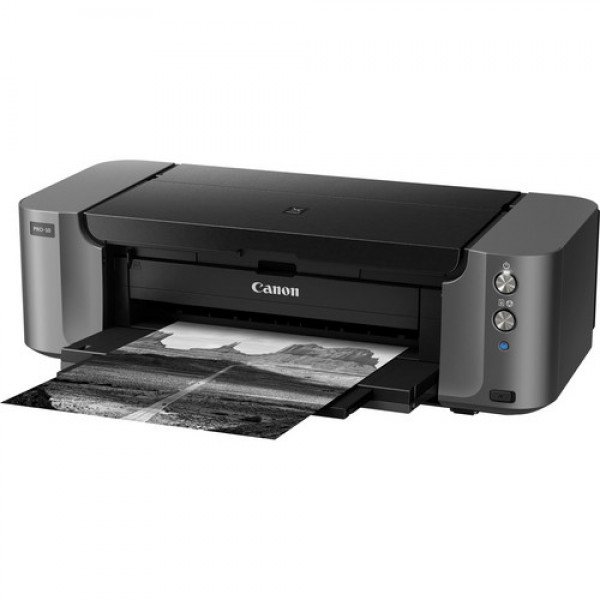


The Canon PIXMA PRO-10 is one of the best pigment ink printers on the market. It’s actually an award-winning printer.
It’s not meant for casual use but rather professional studio printing use and can print photos up to 13 x 19 inches in size, that’s why it comes with a hefty price tag.
Furthermore, the Canon PIXMA PRO-10 is equipped with ten pigment inks with three different shades for black alone. This gives it an amazing capability to print in monochrome photos and produce superior quality prints that bring details to life with a 4800 x 2400 DPI resolution.
The Pixma Pro-10 can print full-sized borderless A4 images in 215 seconds or 3 minutes and 35 seconds on average. That’s pretty slow, but it contributes to how high-quality the output is. nyerőgépes online játékok
Moreover, it’s packed with proprietary technologies such as full-photolithography inkjet nozzle engineering (FINE) and Chroma Optimizer that makes your prints as smooth as possible.
FINE technology enables the Canon PIXMA PRO-10 to print with microscopic droplets while the Chroma reduces the bronzing effect on monochrome images.
As for connectivity, it’s pretty versatile as it can connect through WiFi and is compatible with AirPrint and offers computer-free printing as you can print directly through your phone or your camera.
Pros:
- Good connectivity range with wired and wireless connections
- Quiet operation
- CD printing
Cons:
- Slow speed
- Quite bulky with a large and heavy construction
Bottom Line
Evidently, the Canon PIXMA PRO-10 is not meant for printing normal documents but rather for artistic-grade prints. That’s why it’s pretty slow in operation, and its running cost is pretty high. online tippmix It’s great for home or small scale business whose aim is to produce top-tier output.
4. Epson Stylus C88+ – Best Budget Pigment Ink Printer



If you’re on a budget but still looking for a reliable pigment ink printer, the Epson Stylus C88+ has your back.
It’s more affordable than other options because it only uses four ink cartridges. The fact that it doesn’t use many cartridges also contributes to its printing speed as it’s superior to the rest with 23 PPM for monochrome prints and 14 PPM for color ones.
Using DURAbite ultra pigment ink means that its prints will be waterproof and smudge-proof. Additionally, it prints at a 570 x 1440 DPI resolution, which is pretty great for its price range.
However, it doesn’t come with network connectivity, and its maximum print size is limited to legal-size sheets while its tray is limited to 120 sheets.
Pros:
- Quiet operation
- Affordable relative to a pigment-based inkjet printer
- Amazing quality prints when using good paper and genuine ink
- Easy to set up
- Durable and water-resistant output
Cons:
- Doesn’t have WiFi connectivity
- Uses lots of ink
Bottom Line
Naturally, the Epson Stylus C88+ isn’t packed with technology and doesn’t produce the best quality prints, but for a budget choice, it does a pretty great job. While it isn’t a professional-grade pigment inkjet printer, the Stylus C88+ produces high-quality and super durable prints for an affordable price.
5. Epson SureColor P600 – An Excellent Photo Printer
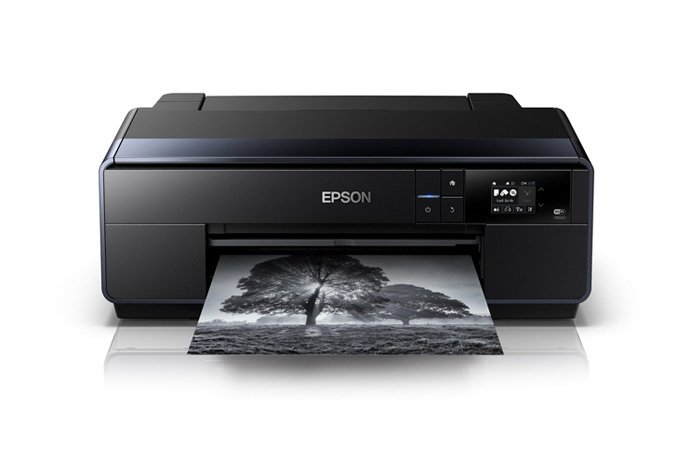


The Epson SureColor P600 is pretty similar to the Epson SureColor P400 in many ways, namely the panoramic printing feature. It does have the edge over the P400, however, as it comes with nine pigment-based ink cartridges instead of only 8. This means that it has better image fidelity.
It has three shades of black and white inks dedicated to printing monochrome prints. Its speed highly varies depending on the size (4 x 6″, 8 x 10″, or 13 x 19″) and the resolution (1440 x 1440 or 5760 x 1440) and whether you have the high-speed option on or off.
You should keep in mind that the more shades of color the printer can produce, the higher the quality of your prints will be, but so will be the cost of printing.
Moreover, it features a 3.5-inch color touchscreen that allows you to control the printing processes. This is a unique feature that no other printer on the list has.
Connectivity options include WiFi and WiFi Direct that enables you to print directly from mobile devices such as smartphones and tablets. It also has wired connectivity through Ethernet or USB ports.
Some downsides include its price and its bulkiness. It comes with three paper trays, which increase its capacity but also the space needed to keep it.
Pros:
- Super high-quality output
- Can print up to 13 x 19-inch cut sheets
- Prints 13 x 129-inch roll paper
- Fine art papers available
Cons:
- Fine art papers might be a little hard to feed
- Can lag for a while sometimes
Bottom Line
If you can get around the few usability issues that face the Epson SureColor P600, you’ll definitely love its top-tier photo and graphics output.
How to Pick a Pigment Ink Printer
When you’re shopping for a pigment ink printer, you probably have the quality of prints and longevity in mind. That’s why you have to keep in mind a couple of things, and these are as follows:
1. The Number of Ink Cartridges
The typical office printer uses around four ink cartridges for four colors: CYMK. However, artistic or photo printers must print with a higher amount of shades, so they must possess a wide gamut, which requires more cartridges.
The number can vary from 1 and up to 12, so which one should you choose? For great colors, your choice will be either a 6, 8, 10, or 12-cartridge system.
Naturally, the more cartridges there are, the more accurate the colors of your final print will be, so you should get the highest number your budget allows.
2. Size of Ink Drops
The battle between Epson and Canon has been going on for years, fighting over which has the thinnest ink drops. This is why all the recommendations I’ve made alternated between the two brands. Right now, Epson takes the lead with a thinness of 3.5 picoliters against 4 for Canon. However, this isn’t a huge difference that the naked eye can spot, so you shouldn’t sweat it.
3. DPI
The DPI or dots per inch of your printer highly affects how precise its action is. Generally, the higher this number is, which measures the resolution of your prints, the better the output is. So if you want the best quality results, you should invest in a printer with a higher DPI, which naturally costs a bit more.
Frequently Asked Questions:
What’s the Difference between Dye-based Inks and Pigment-based ink?
Dye-based inks are those that use a colorant that is soluble in water-based solutions. Pigments ones, on the other hand, are made of fine solid particles suspended in a liquid that doesn’t dissolve.
In other words, the dye-based ones are absorbed by the paper you print on, while pigment ink isn’t.
Can Pigment Ink Be Used with Any Printer?
No. Only a pigment-ready printer can operate with pigment-based inks. Those are typically inkjet printers.
Printers that can print using pigment-based inks can print using dye-based inks as well.
What’s Special About a Pigment Ink Printer?
Pigment-based inks are more specialized and suit specific jobs that require artistic standards. Although their colors aren’t as brilliant as dye-based ink (when using the same number of cartridges), they last for long. Sometimes as long as a hundred years or even more!
Moreover, pigment-based ink isn’t susceptible to light and water damage like a dye-based ink, which is why it’s preferred by graphic designers and professional photographers.
Final Thoughts
It’s true that these printers aren’t cheap, especially if it’s the best pigment ink printer.
The Canon iP8720 is a great choice if you’re looking for a home-based pigment ink printer that gives you good value for the price.
For a small business, you should opt for the Canon Pixma Pro-10.
Finally, if you have even more specific needs like roll printing or high-volume printing, you should opt for the Epson SureColor P400. tippmix radar apk
